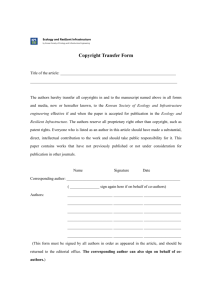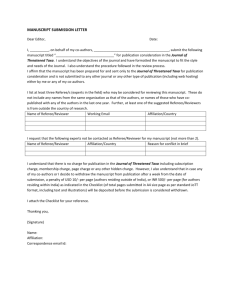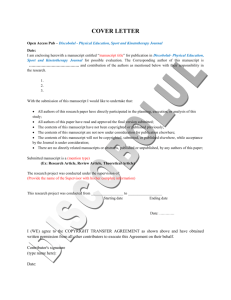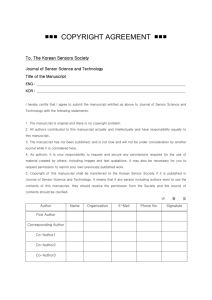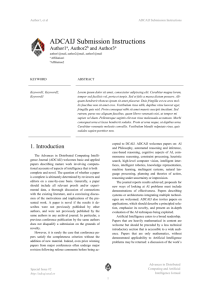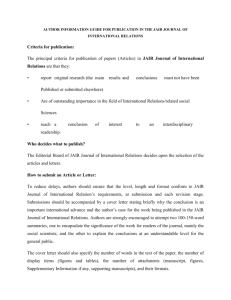Journal of Himalayan Ecology and Sustainable Development
advertisement
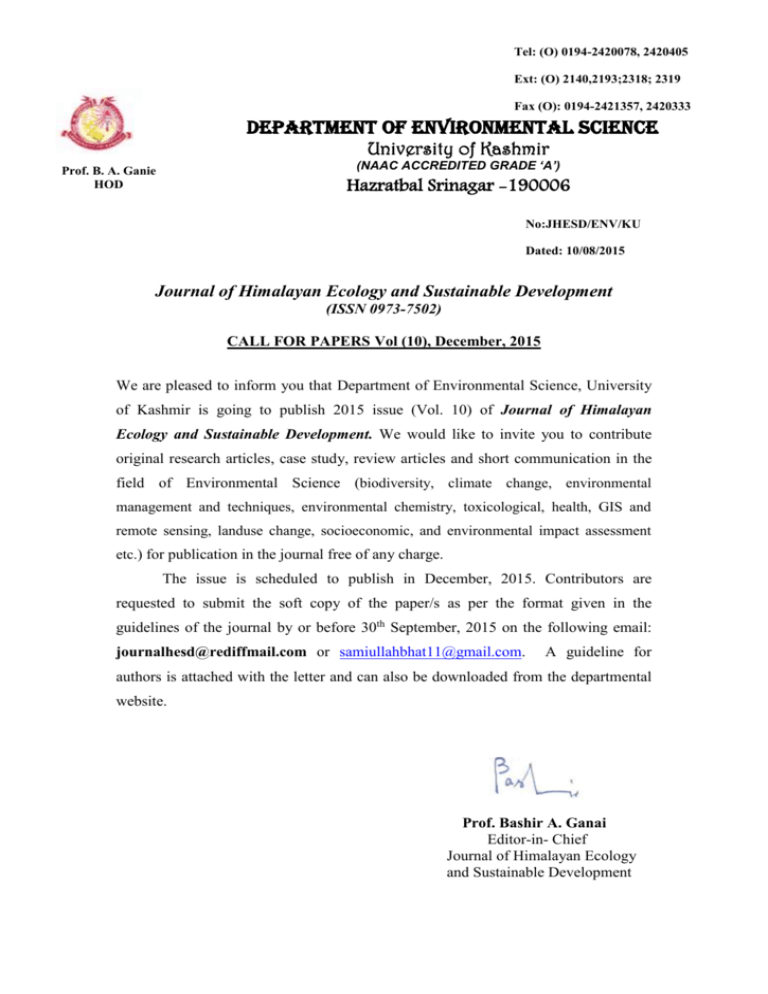
Tel: (O) 0194-2420078, 2420405 Ext: (O) 2140,2193;2318; 2319 Fax (O): 0194-2421357, 2420333 Department of Environmental Science University of Kashmir (NAAC ACCREDITED GRADE ‘A’) Prof. B. A. Ganie HOD Hazratbal Srinagar -190006 No:JHESD/ENV/KU Dated: 10/08/2015 Journal of Himalayan Ecology and Sustainable Development (ISSN 0973-7502) CALL FOR PAPERS Vol (10), December, 2015 We are pleased to inform you that Department of Environmental Science, University of Kashmir is going to publish 2015 issue (Vol. 10) of Journal of Himalayan Ecology and Sustainable Development. We would like to invite you to contribute original research articles, case study, review articles and short communication in the field of Environmental Science (biodiversity, climate change, environmental management and techniques, environmental chemistry, toxicological, health, GIS and remote sensing, landuse change, socioeconomic, and environmental impact assessment etc.) for publication in the journal free of any charge. The issue is scheduled to publish in December, 2015. Contributors are requested to submit the soft copy of the paper/s as per the format given in the guidelines of the journal by or before 30th September, 2015 on the following email: journalhesd@rediffmail.com or samiullahbhat11@gmail.com. A guideline for authors is attached with the letter and can also be downloaded from the departmental website. Prof. Bashir A. Ganai Editor-in- Chief Journal of Himalayan Ecology and Sustainable Development Guidelines for Contributors Original research articles in any branch of science are invited from researchers working in any Research/Academic/Industrial organization for publication in the "Journal of Himalayan Ecology and Sustainable Development” an annual publication of the Department of Environmental Science, University of Kashmir, Srinagar. The Journal of Himalayan Ecology and Sustainable Development covers a wide range of environmental research and monitoring. The journal also includes research a natural resource management actions and pollution risks to man and the environment. The scope of the journal includes research from biodiversity, agriculture, climate change, environmental management and techniques, environmental chemistry, toxicological, health, GIS and remote sensing, landuse change, socioeconomic, and environmental impact assessment etc. Review papers from senior faculty based on thorough critical assessment of published data can also be considered. The manuscript should be submitted along with a certificate stating that the information embodied in the communication has not been published and is not under consideration for publication elsewhere; that its publication has been approved by all co-authors, if any, as well as by the responsible authorities – tacitly or explicitly – at the institute where the work has been carried out. The department will not be held legally responsible should there be any claims for compensation. Authors wishing to include figures, tables, or text passages that have already been published elsewhere are required to obtain permission from the copyright owner(s). Any material received without such evidence will be assumed to originate from the authors. Submission Manuscripts complete in all respects (MS word, 2007 or higher) should be sent to the Head, Department of Environmental Science, University of Kashmir, Srinagar – 190 006, either personally against receipt or by registered post. Papers can also be sent through email on the address journalhesd@rediffmail.com or arshidj@gmail.com. The manuscript should not exceed twenty A-4 size pages (having all round margins of 1.5” and 1.5 lines space in between the lines) including abstract, tables, figures and references. Short communications should not exceed four A-4 size pages. Abstract of the text and title of the papers in the reference list are not required in case of short communications. All papers submitted for publication will be accepted only on the recommendations of the referees. The authors are required to submit a list of three scientists not below the rank assistant Professor/ Scientist working in the field to which the article pertains, in other institutions. Manuscript may generally be organized in the following order: Title Page The title page should include: The name(s) of the author(s) A concise and informative title The affiliation(s) and address(es) of the author(s) The e-mail address and telephone number of the corresponding author Abstract Please provide an abstract of 150 to 250 words. The abstract should not contain any undefined abbreviations or unspecified references. It should contain a very brief description of the study, methods, results and conclusions. Keywords Please provide 4 to 6 keywords which can be used for indexing purposes. Text The text of original research articles should be divided into the following sections: Introduction The Introduction should state the purpose of the investigation and identify clearly the gap of knowledge that will be filled in this study. Materials and methods The Materials and Methods section should provide enough information to permit repetition of the experimental work. It should include clear descriptions and explanations of sampling procedures, experimental design, essential sample characteristics and descriptive statistics, hypothesis tested, exact references to literature describing the tests used in the manuscript, number of data involved in statistical tests, etc. Results and Discussion The Results section should describe the outcome of the study. Data should be presented as concisely as possible - if appropriate in the form of tables or figures, although very large tables should be avoided. The Discussion should be an interpretation of the results and their significance with reference to work by other authors. Conclusions This section should highlight the major, firm discoveries, and state what the added value of the main finding is, without literature references. Acknowledgments Acknowledgments of people, grants, funds, etc. should be placed in a separate section before the reference list. The names of funding organizations should be written in full. References The journal uses APA reference style. See References for more details. Appendices If there is more than one appendix, they should be numbered consecutively. Text Formatting Manuscripts should be submitted in Word (2007). Text should be in English, well written, precise and to the point. The following points should be considered while submitting the manuscript; Use a normal, plain font (e.g., 12-point Times Roman) for text. Use italics where applicable. Use the automatic page numbering function to number the pages. Do not use field functions. Use tab stops or other commands for indents, not the space bar. Use the table function, not spreadsheets, to make tables. Use the equation editor for equations. Save your file in docx format (Word 2007 or higher) Abbreviations should be defined at first mention and used consistently thereafter. Always use footnotes instead of endnotes. All tables and figures are to be numbered using Arabic numerals. Tables and figures should always be cited in text in consecutive numerical order. For each table, please supply a table caption (title) explaining the components of the table. Figure parts should be denoted by lowercase letters (a, b, c, etc.). Footnotes to tables should be indicated by superscript lower-case letters (or asterisks for significance values and other statistical data) and included beneath the table body. Each figure should have a concise caption describing accurately what the figure depicts. Include the captions in the text file of the manuscript, not in the figure file. Figure captions begin with the term Fig. in bold type, followed by the figure number, also in bold type. No punctuation is to be included after the number, nor is any punctuation to be placed at the end of the caption. When preparing your figures, size figures to fit in the column width. Units and Symbols should follow the metric system. The reference list should be arranged alphabetically according to the surname of the first author. More than one reference of the same author(s) for different years should be arranged chronologically. Only the references cited in the text need to be given in the list of References. Abbreviations of journal titles in reference list should follow the forms used in World List of Scientific Periodicals. References should follow the pattern as exemplified below:- . Journal article: i) Hora, S.L. 1951. Fish culture in rice field. Curr. Sci., 29(7): 171-173. ii) Price, T. and Jamdar, N. 1990. The breeding birds of Overa Wildlife sanctuary, Kashmir. J. Bomb. Nat. Hist. Soc. 87(1): 1-15. Chapter in a book: i) Narayan, N.S. and Madhyastha, M.N., 1985. Heavy, metal pollution in India-A review. p. 272-294. In: Current Pollution Researches in India (R.K Trivedi & P.K. Goel, eds.). Environmental Publications, Karad, India. Technical Report: i) Anon. 1980. Annual Report for the year 1979. National Environmental Engineering Research Institute, Nagpur, India.300 pp. Book: i) Jhingran, V.G., 1975. Fish and Fisheries of India. Hindustan Publication Corpn., New Delhi, India. Web references: As a minimum, the full URL should be given and the date when the reference was last accessed. Any further information, if known (DOI, author names, dates, reference to a source publication, etc.), should also be given. Web references can be listed separately (e.g., after the reference list) under a different heading if desired, or can be included in the reference list. Ethical Responsibilities of Authors This journal is committed to upholding the integrity of the scientific record. Authors should refrain from misrepresenting research results which could damage the trust in the journal, the professionalism of scientific authorship, and ultimately the entire scientific endeavour. Important note: the journal may use software to screen for plagiarism. No data have been fabricated or manipulated (including images) to support your conclusions Authors whose names appear on the submission have contributed sufficiently to the scientific work and therefore share collective responsibility and accountability for the results. Changes of authorship or in the order of authors are not accepted after acceptance of a manuscript. Upon request authors should be prepared to send relevant documentation or data in order to verify the validity of the results. This could be in the form of raw data, samples, records, etc.
